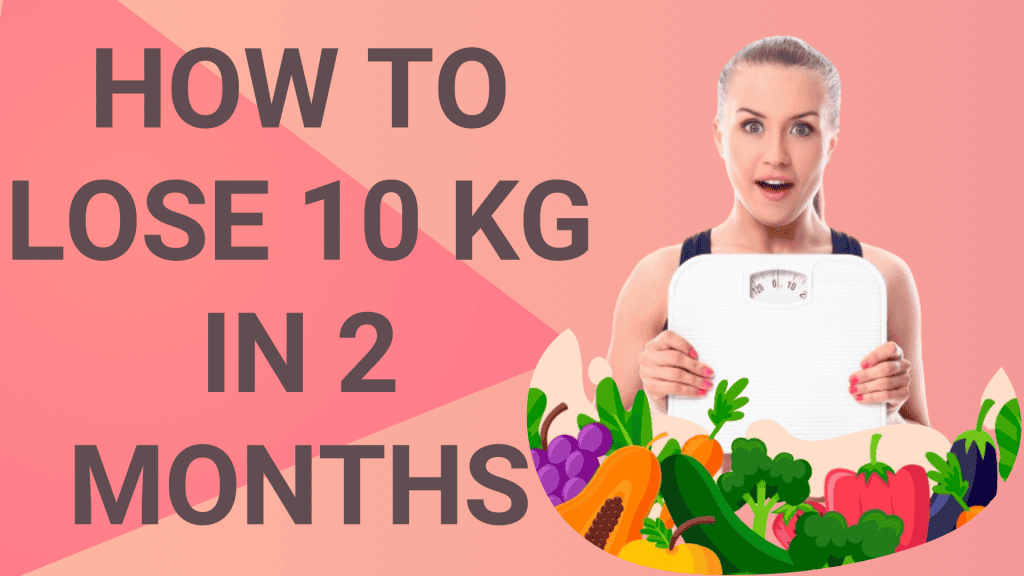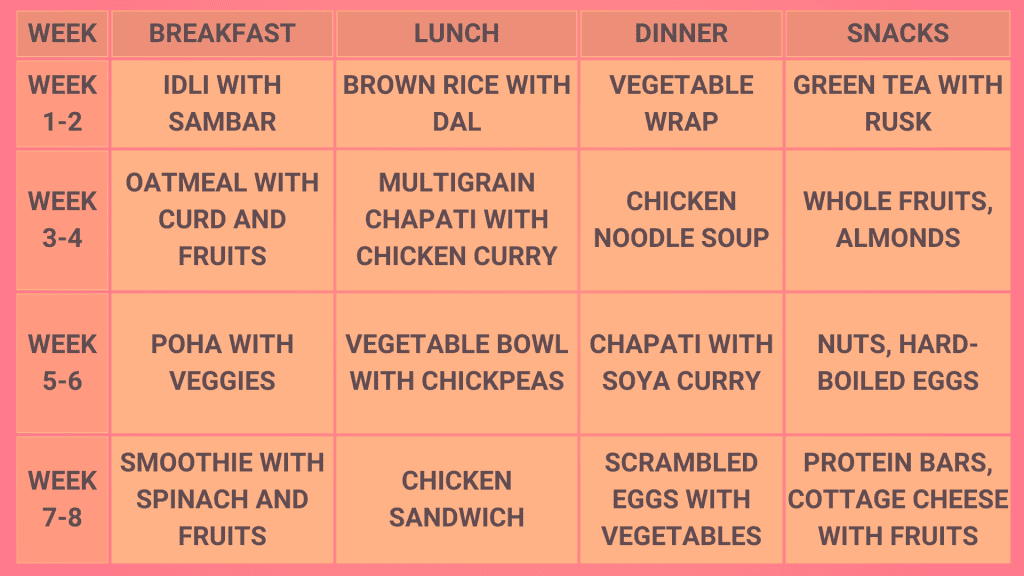Losing 10 kg in 2 months is definitly achievable by combining diet with physical exercises at healthy levels by maintaining a good calorie deficit and paying attention to high intensity exercises for strength and great metabolism. This way you can easily lose all your extra kilos without losing a lot of muscles. Now the question is, can someone actually lose 10 kg in 2 months? The answer is obviously yes. Of course, one should ensure a diet comprising whole foods like fruits, vegetables, lean proteins, and whole grains and limiting processed foods and sweets, following aerobic activities like jogging and swimming as well. Therefore to completely understand how to lose 10 kg in 2 months, start by looking at your daily habits and making needed changes for healthy weight loss.
Is it possible to lose 10 kg in 2 months?
Yes, you can lose 10 kg in 2 months, and it requires only a balanced approach and discipline in diet and exercise. Scientifically speaking, creating a calorie deficit of 500-1000 calories a day through a combination of dietary changes and physical activity can lead to a weight loss of 1-2 pounds a week. To do this, focus on whole foods like protein rich foods, fruits, vegetables, lean proteins, and whole grains, and limit processed foods and sweets. Do at least 150 minutes of aerobic activities like jogging or swimming a week and complement it with strength training to preserve muscle mass and boost your metabolic rate.
10 Ways on How to Lose 10 kg in 2 Months
Losing 10 kg in 2 months is doable if you combine a balanced diet with exercise and healthy habits. Many people look for tips on how to lose 10 kg in 2 months, and a mix of diet and exercise usually works best. This requires dedication and a smart approach backed by science so you get sustainable results. Here are 10 science-backed ways to shed those extra kilos.
- Limit carbohydrate intake
- Reduce salt intake
- Drink more water
- Increase Fiber Intake
- Increase the protein intake in each meal
- Eat a balanced diet
- Control portion of each meal
- Prepare your own meals
- Do exercise to burn more fat
- Take good sleep
1. Limit Carbohydrate Intake
Reducing carbohydrates, especially refined carbs, can lower insulin levels, and the body will use stored fat for energy. A study found that participants who followed a low-carb and low calorie foods diet for 12 weeks lost 7.6% of their body weight compared to 4.2% on a low-fat diet.
2. Reduce Salt Intake
High salt intake can cause water retention and bloating. Reducing salt can minimize water weight and help you get leaner. According to a study, reducing salt intake by 1,000 mg a day can lower blood pressure and reduce bloating, which leads to weight loss.
Tip: Use herbs and spices to flavour your food instead of salt.
3. Drink More Water:
Staying hydrated helps boost metabolism and reduce appetite. Drinking water before meals can also help you eat less. A study found out that individuals who drank 500 ml of water before each meal lost 44% more weight in 12 weeks compared to those who didn’t. Drinking water before meals can reduce food intake and aid in weight loss. Studies show that it decreases calorie intake and increases feelings of fullness. Replacing sugary drinks with Weight loss drinks can further boost weight loss.
Tip: Drink a glass of water before each meal to control your appetite.
4. Increase Fiber Intake
Fiber-rich foods like vegetables, fruits, and whole grains make you feel full for longer and reduce overall calorie intake. Research has found that increasing daily fiber intake to 30 grams can aid in weight loss and overall health. Fiber, especially viscous fiber, makes you feel full by forming a gel that slows down digestion and nutrient absorption. This leads to longer feelings of fullness and reduced food intake. Viscous fiber is found in foods like beans, oats, Brussels sprouts, asparagus, oranges, and flax seeds. Supplements like glucomannan, which is high in viscous fiber, also aid in weight loss.
Tip: Add chia seeds or flaxseeds to your meals for extra fiber.
5. Increase Protein Intake in Each Meal
Protein is consumed for its muscle-building and repairing properties. High protein intake can increase metabolism and lower hunger. A study has reported that a high-protein diet increases calorie burning by 80-100 calories per day.
6. Eat a Balanced Diet
Consume nutrient-rich food to ensure that you refuel your body with all the essential vitamins and minerals so that all parts work properly and aid in weight loss. According to research, a balanced diet that excludes no food can lead to a healthy weight and does not result in diseases such as diabetes, cardiovascular complications, or even certain cancers. How to lose 10 kg in 2 months can seem hard, yet with the 30 30 30 rule for weight loss, it’s definitely possible.
7. Control Portion Sizes
Keeping portions in mind will prevent one from overeating. Using smaller plates or measuring portions avoids excess intake of calories. Research proved that people ate 22% less when they used smaller plates. Using smaller plates makes portions appear larger and can trick the brain into feeling fuller with less food. On the contrary, bigger plates mean more food consumption. By using smaller plates for calorie-dense foods and larger plates for nutrient-dense, lower-calorie food items, one can effectively bring down the overall calorie intake.
Tip: Eat on a smaller plate to avoid overeating.
8. Prepare Your Own Meals
How to lose 10 kg in 2 months can seem hard, yet when your food is prepared at home, you know exactly what goes into it and can keep the portion under control. Moreover, you will only intake a few extra calories, which often get added to restaurant foods. According to a study, those who cooked frequently at home consumed fewer calories and less fat than those who frequently visited restaurants. For preparing your own meals one must know How to make a diet chart efficiently to manage the weight loss goals.
Tip: Aim for a colourful plate with a variety of vegetables to ensure a good range of nutrients.
9. Exercise to Burn More Fat
By incorporating aerobic exercise along with some form of strength training, you trigger an increased calorie burn and really knock on the fat. When combined, these should help bring down body fat, but not with aerobic exercise alone. If your aim is How to lose 10 kg in 20 days, then focus on building habits that keep you healthy and help you lose weight quickly.
10. Take Good Sleep
Adequate sleep plays an important role in weight loss. A lack of good sleep might disturb the hormonal balance, increasing appetite beyond normal and thus leading to weight gain. A Research article assessed that people sleeping less than 5 hours a night had a 55% increased risk of developing obesity compared with young adults sleeping 7-8 hours. It will upset the appetite-controlling hormones, like leptin, ghrelin, and cortisol, which are involved in energy metabolism. The resulting hormonal imbalance increases appetite and cravings and causes greater caloric intake. One may also have a higher risk of obesity and type 2 diabetes when one is sleeping poorly and under stress. Not only is good sleep hygiene essential for practising stress management, but these 2 factors are also key promoters of a healthy weight.
Diet Plan to lose 10 kg in 2 months
It’s important to focus on balanced meals that include all food groups to make a diet plan easy to follow and healthy. Here’s a sample Low budget diet plan for weight loss for 2 months:
Week 1-2:
- Breakfast: Idli with Sambar—This South Indian dish is perfect for weight loss. 2 medium-sized idlis with half a bowl of sambar are 230 calories.
- Lunch: Brown Rice with Dal – Rich in fiber and antioxidants, this combo has multiple health benefits. Add sliced cucumber, onions and tomatoes for extra nutrition.
- Dinner: Vegetable Wrap—2 whole wheat wraps with mixed vegetables are nutritious, tasty, and easy to make.
- Snacks: Green Tea with Rusk – Ditch regular tea for green tea and pair it with 2 whole wheat or sooji rusk slices.
Week3-4:
- Breakfast: Oatmeal with Curd and Fruits – A healthy bowl of oatmeal with skimmed milk or homemade curd topped with a ripe banana, grapes, diced apples and berries.
- Lunch: Multigrain Chapati with Chicken Curry—2 multigrain chapatis with a bowl of chicken curry are a fiber—and protein-rich meal.
- Dinner: Chicken Noodle Soup – A bowl of chicken soup with boiled wheat noodles, cooked carrots, cabbage, spring onions and sweet potatoes.
- Snacks: Whole Fruits, Almonds—Whole fruits like bananas, apples, guava, or pears and four almonds make a healthy snack on the go.
Week 5-6:
- Breakfast: Poha with Veggies – Cooked with a spoon of ghee, mustard seeds, chopped veggies, coriander leaves, and lemon juice, poha keeps you full for several hours.
- Lunch: Vegetable Bowl with Chickpeas—A nutritious mix of boiled vegetables (carrots, beets, beans, broccoli) and boiled chickpeas seasoned with salt and lemon juice.
- Dinner: Chapati with Soya Curry—Soya curry is rich in proteins and fiber. Pair it with 2 chapatis.
- Snacks: Nuts, Hard-boiled Eggs – 4 almonds, a few raisins and 2 hard-boiled eggs (with one yolk).
Week7-8:
- Breakfast: Smoothie with Spinach and Fruits—Blend spinach, apple, carrot, beetroot, banana, cucumber, water, curd, and honey for a healthy smoothie. Carry four soaked and peeled almonds.
- Lunch: Chicken Sandwich – Multigrain bread stuffed with grilled chicken breast, tomato slices, onion rings and lettuce leaves.
- Dinner: Scrambled Eggs with Vegetables – Scrambled eggs with finely chopped vegetables and a bowl of leftover dal from lunch.
- Snacks: Protein Bars, Cottage Cheese with Fruits – Sugarless homemade protein bars with dry fruits and dates, and cottage cheese with fruits.
Foods to Avoid When Losing 10 kg in 2 Months
When you want to lose 10 kg in 2 months, it is very important to watch what you eat. Some foods can slow your progress and even cause more weight gain. Avoiding these foods can help you reach your weight loss goals faster.
- Sugary Beverages
- Processed Foods
- Refined Carbs
- Fried Foods
- Sweets and Desserts
- High-calorie snacks
- Alcohol
- High-Sodium Foods
1. Sugary Beverages
Drinks with lots of sugar, like soda, fruit juice, and energy drinks, have many added sugars but no real nutrition. Because of this, these beverages can raise blood sugar fast. This often leads to storing more fat in the body and feeling a strong desire for even more sugary foods later on.
2. Processed Foods
Prepared foods such as chips, cookies, and frozen meals usually contain large amounts of unhealthy fats, sugars, and salt. These ingredients can lead to weight gain, make people feel hungry again soon after eating them, and negatively impact health. Therefore, opt for whole, unprocessed foods and fruits for weight loss to give your body the nutrients it needs.
3. Refined Carbs
Refined carbohydrates, such as white bread, pastries, and white rice, lose their fiber and nutrients during processing. These foods cause blood sugar levels to rise quickly and then fall just as fast. This can make people feel hungry quickly again and might cause them to eat more than they need. The better option is to choose whole grains like brown rice, quinoa, and whole wheat bread.
4. Fried Foods
Fried foods usually have many bad trans fats and lots of calories. If you eat fried foods on a regular basis, it can make you gain weight and increase the risk of heart problems. So, maybe instead, you can try to bake, grill, or steam the food along with Fruit Salad for Weight loss, which will keep nutrients and does not add extra fat to your food.
5. Sweets and Desserts
Sweet foods and desserts like cakes, cookies, and ice cream have lots of sugar and bad fats. Eating these treats can make you gain weight. They also make you want to eat more sweets and can cause problems with keeping your blood sugar level balanced. Opt for healthier alternatives like fruit or dark chocolate in moderation.
6. High-calorie snacks
Snacks with lots of calories, like potato chips, nachos, and cheese puffs, do not have many nutrients, but they contain high amounts of calories and bad fats. Eating these snacks can quickly ruin your plan to lose weight because they add too many extra calories to what you eat each day. Therefore, choose weight loss foods and nutrient-dense snacks like nuts, seeds, and fresh vegetables instead.
7. Alcohol
Drinks with alcohol have many empty calories, and they can make it harder for you to think clearly. This might cause you to select unhealthy foods. Also, metabolism slows when consuming alcohol, which reduces fat-burning capacity in the body. So controlling or not having alcohol at all may help greatly in losing weight.
8. High-Sodium Foods
Foods having high sodium content, like canned soups, processed meats and fast food, can make you retain water and bloat. Consuming excessive salt can also enhance the possibility of high blood pressure along with other health troubles. Hence, choose fresh foods that are not processed and flavour your dishes with herbs or spices instead of salt.
How to Calculate Daily Calorie Intake to Lose 10 kg in 2 Months
Calculating your daily calorie intake involves knowing your Basal Metabolic Rate (BMR Calculator) and activity level. BMR is the number of calories your body needs to maintain essential physiological functions at rest. Use the Harris-Benedict equation to estimate your BMR and then adjust based on your activity level to get your total daily energy expenditure (TDEE). Create a calorie deficit from this number to lose weight. For example, if a person has a BMR of 1500 calories and a moderate activity level, their TDEE might be around 2000 calories. To lose 1kg per week, a daily deficit of 7700 calories divided by seven days (about 1100 calories per day) is needed. Adjust this based on individual goals and responses.
Tip: Use a Daily calorie intake calculator to track your intake and stay within your target range.
Is it Healthy to Lose 10 kg in 2 Months?
Losing 10 kg in 2 months is very ambitious but can be healthy if done properly with a good plan that mixes a diet full of nutrients with regular exercise. Also, it is very important to eat many different foods that give necessary nutrients while keeping fewer calories to lose fat. Drinking enough water and having a proper sleep is important, too. However, it is very important to be cautious about losing weight quickly and ask healthcare professionals for advice. This way, you can make sure your body gets all the needed nutrients and muscles remain strong. This means looking at how you are doing often and changing your plan when needed is key to success.
Tip: Try relaxation techniques like meditation or deep breathing exercises to help reduce stress.
Top 10 Tips On How To Lose 10 Kg Weight in 2 Months As Fast As Possible
To lose 10 kg in 2 months, you have to use different methods like exercise and diet. Here are 10 Tips and Tricks that can help you lose 10 kg weight quickly without causing too many health problems:
- Tip 1: Keep a food diary to track your eating habits. This can help you identify patterns and areas for improvement.
- Tip 2: Choose whole grains over refined grains for better nutrient intake.
- Tip 3: Carry a water bottle with you so you can drink enough throughout the day.
- Tip 4: Start your meal with a salad or vegetable soup to increase fiber intake and control hunger. At each meal, have some protein, such as chicken, fish, tofu, or beans.
- Tip 5: Use the plate method; fill half your plate with vegetables, one quarter with protein, and another quarter with whole grains.
- Tip 6: Do batch-cooking, then freeze it so that you can save time and always have healthy fallback options.
- Tip 7: The most effective way to do this is with HIIT, which provides maximum calorie burn in a short amount of time.
- Tip 8: Meal prep on weekends to ensure you have healthy options available during busy weekdays.
- Tip 9: Replace sugary drinks with water or herbal teas to cut down on calories and stay hydrated.
- Tip 10: Consult a nutritionist or dietitian and Buy Weightloss diet plan to create a personalized plan for you.
Expert Review on How to Lose 10 kg in 2 Months
According to Dr Navita Kumari, to Lose 10 kg in 2 months a planned approach that includes a balanced diet and exercise. Focus on whole foods, enough protein, and regular physical activity. Monitor and adjust as you go to stay healthy and prevent muscle loss. She also says that it is an achievable goal that can be healthy if done correctly with the guidance of trainers and dieticians.
References
“Diet & Weight Loss.” n.d. Harvard Health. Accessed July 24, 2024. https://www.health.harvard.edu/topics/diet-and-weight-loss.
Hall, Kevin D. n.d. “Maintenance of lost weight and long-term management of obesity.” NCBI. Accessed July 24, 2024. https://www.ncbi.nlm.nih.gov/pmc/articles/PMC5764193/.
“Weight-Loss and Maintenance Strategies – Weight Management.” n.d. NCBI. Accessed July 24, 2024. https://www.ncbi.nlm.nih.gov/books/NBK221839/.
FAQs
1. Can we lose 10 kg in 2 months?
In addition to adjusting your diet, adding some exercise can help you to lose 10 kilos in 2 months. Don’t you like intense exercise? That is no problem; 30 minutes of exercise a day is enough. Try a walk, bike ride, or swimming into your daily routine, such as walking to work or during lunch breaks.
2. How long will it take to lose 10 kg?
The time required to lose 10 kg of body weight varies based on several factors. The average healthy weight loss is 0.5 kg to 1 kg per week. Therefore, losing 10 kilograms would take approximately 10 to 20 weeks or 2.5 to 5 months.
3. How much walk to lose 10 kg?
Brisk walking or power walking for 30 minutes a day, five days a week, can help you lose up to 10 kg.
4. Is losing 10 kg in 2 months realistic?
As a general rule of thumb, you will need at least 3-4 weeks to drop 3-5kg and up to three months to lose 10kg. This means that focusing on your diet and exercise goals for a couple of weeks without distraction and excess calories will go a long way toward getting your weight loss efforts off to the right start.











Thankyou for the article you are in inspirations to us all.Here is the great way I found to lose weight here I hope it helps others. https://bit.ly/3SzOzQG